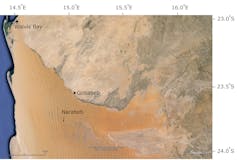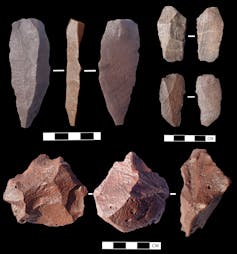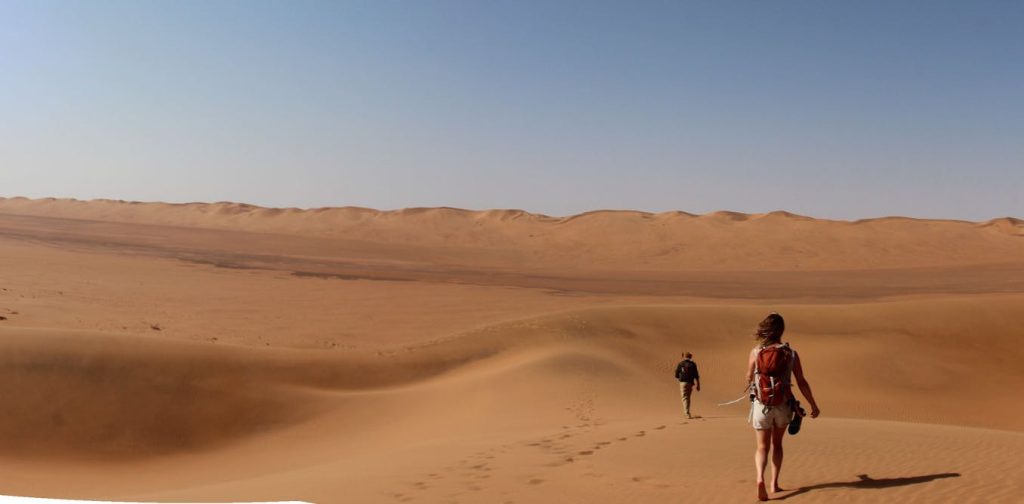Desert North Africa And that Arabian Peninsula It has been well studied by archaeologists. Homeland of early humans and, Migration Parallel “Green Corridor”
The archaeology of the desert west coast of South Africa has not received similar attention.
Part of the Namib Desert, the Namib Sand Sea lies on the west coast of Namibia. It’s an extremely arid landscape of towering sand dunes that covers around 34,000 km² between the town of Lüderitz in the south and Walvis Bay in the north. However, there are clues that suggest this environment was not always so arid and inhospitable, suggesting there is still more to learn about ancient human life here.
Google, Image: Landsat/Copernicus
We are part of an interdisciplinary research team of physical geographers, archaeologists and geospatial scientists interested in the long-term history of the desert and human-environment interactions.
our the study It dates the existence of a small freshwater lake in the Namib Desert that was once fed by an ancient river and has a rich record of ancient stone tools surrounding it. African Mesolithic (dated between approximately 300,000 and 20,000 years ago) indicates that people walked on the land and occasionally used the water source.
Dating the Nalabeb site, a former lake site, sheds light on when ancient humans could have lived here, highlighting the Namib Desert as a place for archaeologists to study to learn more about the widespread and deep human connections across Southern Africa.
Ancient lakes and shifting sand dunes
Today, Narrabeb is a landscape of long sand dunes rising more than 100 metres from the site of an ancient lake. There are no pools of water and very little rain most of the year. But that’s probably not what our ancient ancestors saw here. Away from the lake, there may have been a relatively flat plain, seasonally covered with grass, next to the river.
The clues lie in the site’s sediments – layers of mud deposited by water. To know when there was a lake at Narrabeb, the researchers needed to date these layers.

Karlina Ephraim (Contributor)
we, Luminescence dating – Basically, it tells the time by making the sand glow. The sand grains release a trapped signal, which accumulates when the sand is buried, and resets when the sand is exposed to sunlight. Using this technique, we can date when the different layers last came to the surface before they were buried. We dated the sand above and below the mud layers that were deposited by water. We found that there was a lake at Narrabeb between 231,000 ± 20,000 years ago and 223,000 ± 19,000 years ago, and again around 135,000 ± 11,000 years ago.
Another clue is the shape of the landform east of the Narabeb. The absence of sand dunes suggests that ancient humans were not the only ones moving through the Namib Desert. Have they been moving? For how long? And how fast?

Google, Copernicus
It’s logistically impossible to drill into the center of the dune and figure it out. New Mathematical Model.
Modelling suggests that it took approximately 210,000 years for the sand to accumulate around Narrabeb, a 110-metre-high sand dune, which is remarkably close to the lake’s oldest date. This suggests that the dunes were just beginning to form, and that a river was providing fresh water to the lake, feeding animals and attracting people. Sediments at Narrabeb also clearly show that a river once flowed through what is now the dune.
Winds are pushing the dunes from the south and west to the north and east, creating barriers to rivers and preventing the movement of people and animals along the waterways.
The presence of ancient people
in Elsewhere in the Namib We discovered Early Stone Age Early seed tools Homo This is part of a growing body of evidence from studies in the Kalahari Desert of central South Africa. South Africa’s desert landscape is more important The story of human evolution and technological innovation is more fascinating than previously thought.
The remains at Narrabeb fit into the Middle Stone Age lithic technology. Narrabeb is a particularly tool-rich site, suggesting that people have been making tools here for a long time and perhaps visiting the site for generations.

George Reeder (collaborator)
This study highlights the need for comprehensive study of unmapped areas as major routes for human and animal migration, which may reveal interesting records. cultural Diffusion, innovation, and adaptation to marginal and changing environments.
Our findings also provide insight into the dynamic nature of environmental conditions in one of the oldest desert regions on Earth. The Namib Desert has been very consistent It has been dry for about 10 million years It was not a place that could accommodate a “green corridor” at a time that archaeologists would be interested in. Now we can challenge that idea.
Next steps
Recent funding Leverhulme Trust This will enable us to expand our fieldwork, document archaeological remains and date these ‘green corridors’ across an even larger area of the landscape. Initial 100 mile (160 km) walk Surveys along the ancient river have revealed vast landscapes littered with artifacts, and we still need to learn more about where ancient people found the materials they used to make stone tools.
This will allow us to piece together a network of archaeological sites and show possible locations of human movement in this part of South Africa – previously a gap in the archaeological map.
read more:
Ancient jars hold clues about why South African nomadic peoples thrived on a diverse diet
Further research is also needed to understand the climatic changes that allowed the river to flow into the Namib. This southern hemisphere’s west coast desert has a completely different environment to that of North Africa and Arabia. Great framework Continued research with the wider scientific community, including climate modellers, to understand the cyclical “green corridors” may produce a clearer picture of the Namib “green corridor”.


